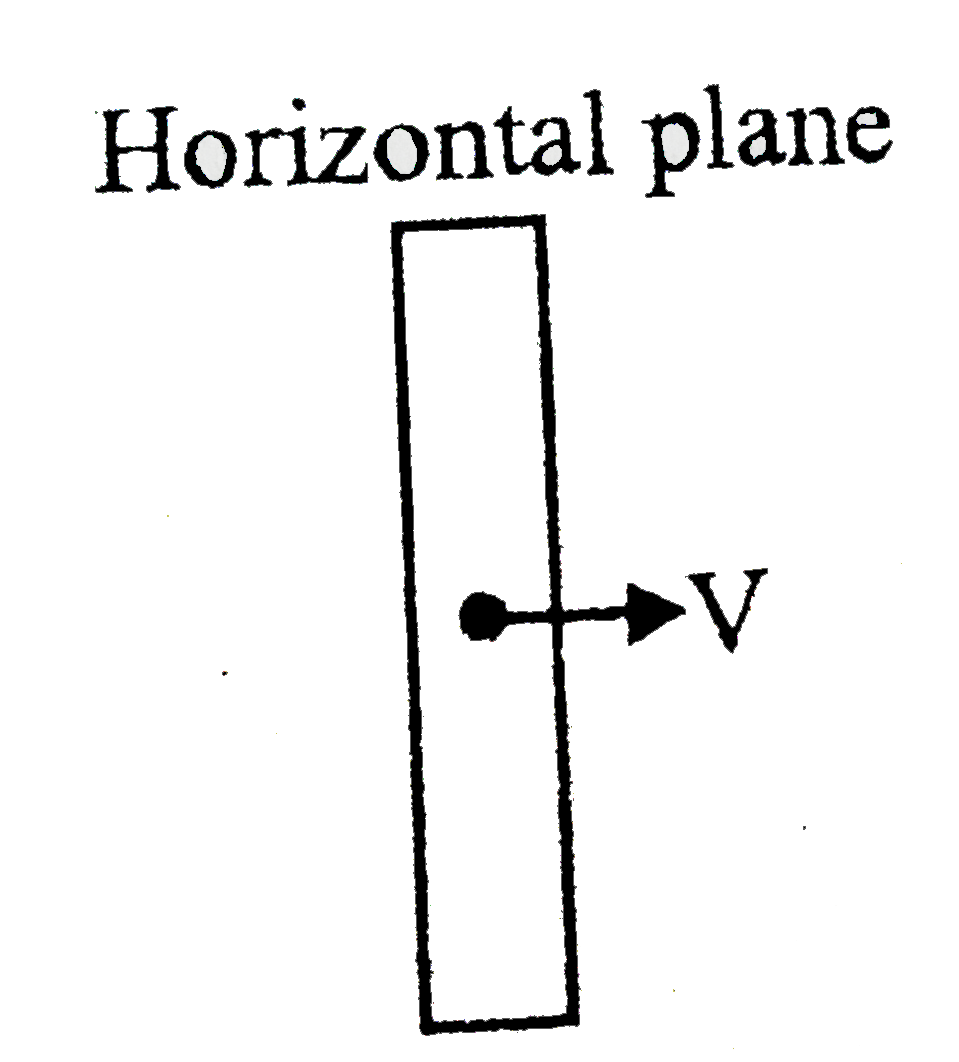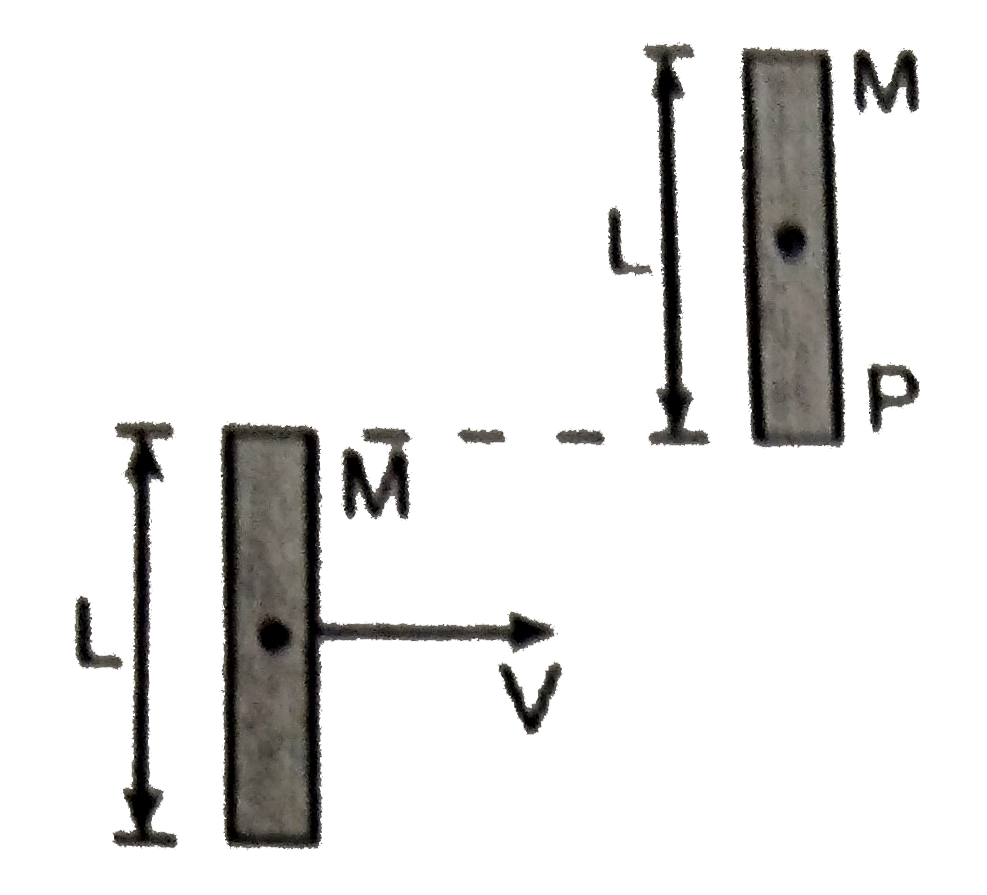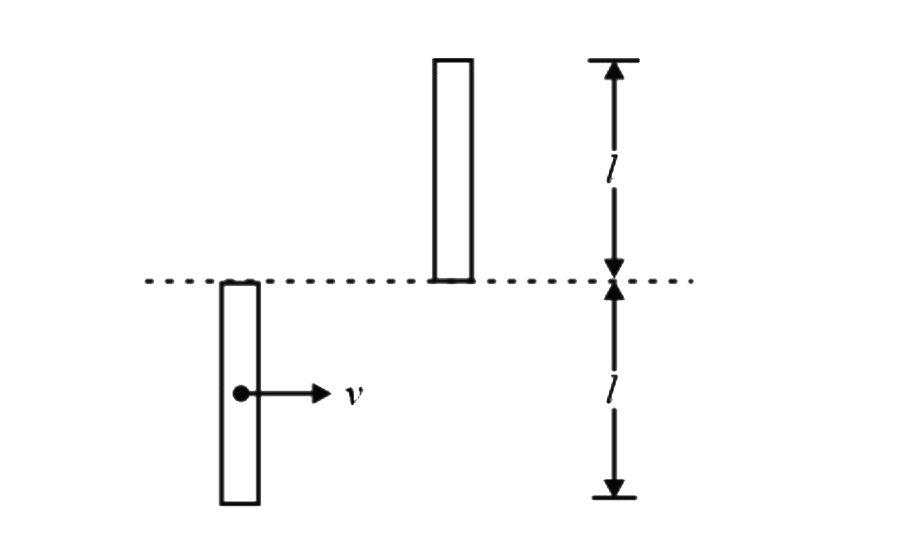A 200kg beam 2.0 m in length slides broadside down the ice with a speed of 16m/s (figure). A 50 kg small favicol can (guranteed sticking ) at rest sticks at one end as it goes past, both go spinning down the ice. Assume frictionless motion. What is the angular velocity of combined mass in rad/s.

The correct Answer is:6
After collision let velocity of centre rod is v' and angular velocity ω.
Applying conservation of angular momentum about point 'P' on ground (see figure) we get
MvL2=Mv'L2+(ML212)ω.....(1)

from conservation of momentum we get
Mv=Mv'momentum of rod+m(v'+L/2ω)momentum of particle....(2)
On solving (1) and (2) we get
ω=6rad/sec
Topper's Solved these Questions
- BOOK - BANSALCHAPTER - TEST PAPERSEXERCISE - PHYSICS PART (A)32videos
TEST PAPERS
- BOOK - BANSALCHAPTER - TEST PAPERSEXERCISE - PHYSICS PART (B)3videos
TEST PAPERS
- BOOK - BANSALCHAPTER - TEST PAPERSEXERCISE - PHYSICS PART- C4videos
TEST PAPERS
- BOOK - BANSALCHAPTER - SEMICONDUCTORSEXERCISE - CBSE Question32videos
SEMICONDUCTORS
Similar Questions
Two balls each of mass 0.25kg are moving towards each other in a straight line,one at 3m/s the other at 1m/s collide.The balls stick together after the collision.The magnitude of the final velocity of the combined mass in ms−1 is?
View SolutionA rod of mass 2kg and length 1m is pivoted at one end A and kept on a smooth surface. A particle of mass 500gmstrikestheotherendB of the rod and sticks to the rod. If particle was moving with the speed of 20m/s, what is the angular speed of the rod after collision ?
 View Solution
View Solution
Knowledge Check
- Question 1 - Select One
A body A of mass 5kg is moving along the x-axis with a velocity 2m/s. Another body (B) of mass 10 kg is moving along the y-axis with a velocity √3m/s. They collide at the origin and stick together. What is the final velocity of the combined mass?
A√3m/sB(√3+1)m/sC43m/sD2(√3+1)m/s - Question 2 - Select One
A bar of mass M and length L is in pure traslatory motion with its of mass velocity V . It collides with and sticks to a second identical bar which is initially at rest . ( Assume that it bocomes one composite bar of length 2L). The angular velocity of the composite bar will be
 A34VL clockwiseB43VLL clockwiseC34VL counterclockwiseDVL counterclockwise
A34VL clockwiseB43VLL clockwiseC34VL counterclockwiseDVL counterclockwise - Question 3 - Select One
A metre stick is pivoted about its centre. A piece of wax of mass 20 g travelling horizontally and perpendicular to it at 5 m/s strikes and adheres to one end of the stick so that the stick starts to rotate in a horizontal circle. Given the moment of inertia of the stick and wax about the pivot is 0.02 kg m2, the initial angular velocity of the stick is :
A1.58 rad/sB2.24 rad/sC2.50 rad/sD5.00 rad/s
A ball of mass 0.50 kg moving at a speed of 5.0 m/s collides with another ball of mas 1.0 kg. After the collision the balls stick together ane remain motionless. What was the velocity of the 1.0 kg block before the collision?
View SolutionIn the figure (i) a disc of mass M(kg) and radius R(m) is rotating smoothly about a fixed vertical axis AB with angular speed 26rad/s A rod rod CD of length R2(m) and mass M(kg) is hinged at one end at point 'D' on the disc. The rod remains in vertical position and rotates along with the disc about axis AB. At some moment the rod CD gets a very smal impulse at point 'C' due to air due to which the rod falls on the disc along one radius and sticks to the disc as shown in figure (ii). Now find the angular velocity of the disc in rad/s.
 View Solution
View SolutionA bar of mass m and length l is in pure translational motion with its centre of mass moving with a velocity v. It collides and sticks to another identical bar at rest as shown in the figure. Assuming that after the collision the system of the two bars becomes one composite bar of length 2l, then the angular velocity of the composite bar will be
 View Solution
View SolutionA body of mass 1.5kg moving with a velocity of 10m/s encounters another body of mass 2.5kg moving in opposite direction with a velocity of 16m/s, and they stick to eachother. What is the velocity of combination?
View SolutionA stone of mass 1 kg is thrown with a velocity of 20 m/s across the frozen surface of a take and it comes to rest after travelling a distance of 50 m . What is the magnitude of the force opposing the motion of the stone ?
View Solution

